New Chemical Bond Confirmation Calls to Revise Science Textbooks

Researchers in Canada have proven the existence of a hypothetical chemical bond called ‘vibrational bond’, predicted more than 25 years ago.
The bond hypothesized by Donald Fleming from University of British Columbia way back in 1989, was confirmed by researchers in a reaction between bromine and muonium- a hydrogen isotope. Fleming had predicted the formation of an intermediate structure held by an oscillating atom lend by muonium, something like a Ping Pong ball bouncing between two bowling balls.
However, with unavailability of equipments sensitive enough to measure these millisecond long interactions, Fleming had to wait 25 years to confirm existence of such a bond. However, thanks to current developments, researchers conducted experiments at Rutherford Appleton Laboratory in England three years ago which led to the conclusion to the existence of a new bond.
Researcher’s noticed that the reaction between bromine and muonium slowed even thou the temperature was steadily rising, in contrast to the basic thermodynamic theory that the rate of a reaction increases with temperature. According to the author’s, “BrMuBr is stabilized at the saddle point of the potential energy surface due to a net decrease in vibrational zero point energy that overcompensates the increase in potential energy.”
The team that comprised of researchers at Free University of Berlin and Saitama University in Japan lead by Fleming himself published the results in Angewandte Chemie International Edition. Researchers predict that this bond could exist between other atoms that include a heavy and light atom.

